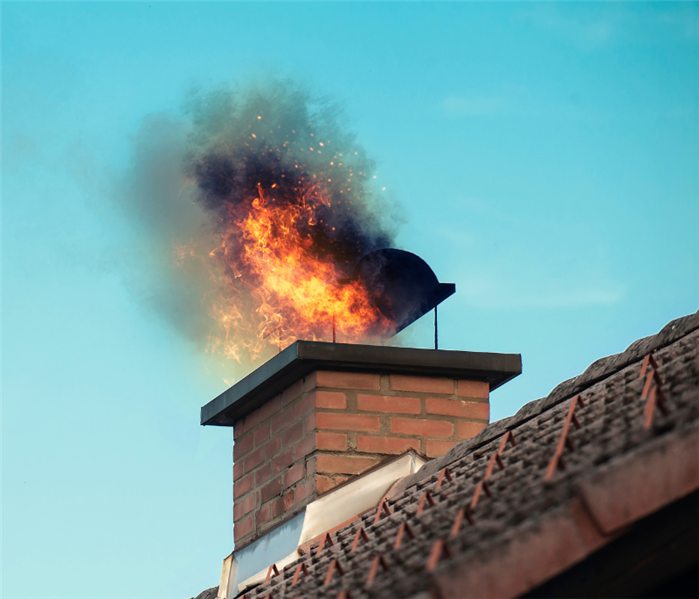Signs of A Chimney Fire & How To Prevent One
10/27/2020 (Permalink)
 Taking steps to prevent a chimney fire in your home can save you thousands in fire damage and possibly save your life.
Taking steps to prevent a chimney fire in your home can save you thousands in fire damage and possibly save your life.
Using your fireplace during the winter months can help keep your heating costs down and make your home feel relaxed and cozy. But if you forget about your dirty chimney, you're putting your home at risk of a fire. Here we will go over the signs of chimney fires and how to prevent them.
What Causes Chimney Fires?
A fire in your chimney is caused by a buildup of creosote. When you burn wood, it gives off by-products of combustion which includes smoke, water vapor, gases, unburned wood particles, tar, and assorted minerals. These by-products travel from the hot hearth and up the relatively cooler chimney, which causes condensation along the flue. This condensation causes the by-products of a fire to collect over time inside the chimney, producing what we call creosote.
Creosote buildup appears in many different forms. It can be crusty, flaky, or puffy, tar-like and sticky, or even shiny and hardened. Creosote in any form is highly combustible, posing a major fire risk to your home when it causes a dirty chimney. Once creosote begins to collect, it will continue as the buildup will restrict the air supply of the chimney and create conditions for more creosote to buildup.
When creosote is built up enough, high temperatures from a roaring fire in the hearth are enough to catch the creosote on fire. Crackling wood or debris floating up the chimney can cause the highly flammable creosote to catch on fire as well.
Signs of the 2 Types of Chimney Fires
Fast-Burning Chimney Fire
These types of fires are extremely obvious when they happen and can even be seen by your neighbors. Fast-burning chimney fires rapidly consume the flammable creosote on the inside of the chimney. The larger amount of creosote there is the more intense the fire will be.
Signs of fast-burning chimney fires are:
- Loud crackling or popping noises from the chimney, similar in sound to a large bonfire
- Large amount of dense smoke coming out of the fireplace or the top of the chimney
- Flames coming out of the top of the chimney
- Pieces of flaming creosote dropping down into the fireplace
- Strong, hot smell
- A loud roaring sound, many times compared to a train or airplane going by
If you notice any of these signs in your home, immediately get everyone out of the house and call 911. While the fire is contained in your chimney, it can easily spread to other parts of the home as it continues to burn.
Slow-Burning Chimney Fire
These types of fire are not so easy to detect and can happen without you ever even knowing. Slow-burning chimney fires start the same way as fast-burning, but these do not have enough fuel or oxygen to be visible or audible while they burn.
Although they are not as explosive as fast-burning fires, they can cause just as much damage over time. You may not know what type of damages slow burning fires are causing until it is too late. Over time, these slow-burning fires can weaken the sides of the chimney enough to spread to your house.
Signs of slow-burning chimney fires are:
- Puffy creosote. This means that the creosote has lit on fire at some point, as it is usually flat and shiny
- Warped metal components. This an include the damper, chimney cap, or the metal pipes of wood stoves
- Heat damage to the roof
- Cracked or damaged flue tiles, or some that are missing
- Finding chunks of creosote outside or inside the fireplace
- Cracks on the outside masonry of the chimney
- Seeing smoke escape through the sides of the chimney
It's important to remember that all these signs indicate that there has already been a fire in your chimney and that you need to immediately take steps to have your chimney inspected and cleaned by a certified chimney sweep. Do not use your fireplace after you have identified any of these signs. Unfortunately, many of these cannot be detected unless you are on the roof or are a chimney professional.
Preventing Chimney Fires
- Schedule regular inspections for your chimney system to catch problems before they start
- Be sure to have a professional clean your chimney at least once a year to prevent excessive creosote buildup
- Burn properly seasoned wood that will burn more cleanly and produce less by-products of combustion
- Make sure that there is proper airflow for your chimney, as this is a factor that helps creosote buildup
- Don't burn roaring fires that aren't the appropriate size for your fireplace, as the heat can cause creosote to catch on fire






 24/7 Emergency Service
24/7 Emergency Service